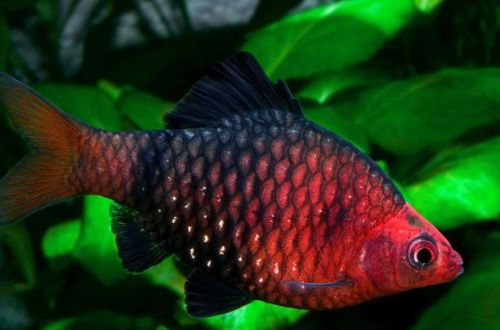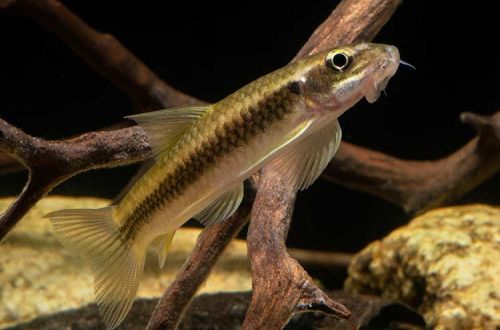
Barbus black
Black barb or Purple-headed barb, scientific name Pethia nigrofasciata, belongs to the Cyprinidae family. Beautiful bright and very mobile fish. It is perfectly adapted to the conditions of a home aquarium, since the vast majority of fish on sale are bred in captivity. Compatible with many peaceful tropical fish.

Currently, in the natural environment, this species is on the verge of extinction. The mass capture of wild individuals (now prohibited by law) has changed the structure of the population, bright color forms are extremely rare. The view has almost lost its original coloration.
Contents
Habitat
It is endemic to water bodies in the southwestern part of Sri Lanka, where the remains of tropical rainforests are still preserved. As of 2006, only 4.6% of the area of the original jungle remains. The black barb lives in clear streams and channels with dense vegetation flowing under the forest canopy. The water is often colored light brown due to the large amount of dissolved organic matter (grass, leaves, etc.). The typical substrate is sandy, covered with a layer of fallen leaves.
Description
Laterally flattened body with large shiny scales. The color is golden-pink with wide dark transverse stripes. In males, during the mating season, the head acquires a dark ruby hue, and the other part of the body is often completely painted in a dark color. The scales have a shiny dark edging. Females are noticeably lighter, the predominant color is light yellow.
Food
With pleasure they accept any quality food (flakes, granules, etc.) with herbal supplements. The variety of food and the presence of protein products in the composition is important.
Maintenance and care
Setting up an aquarium is fairly straightforward, with the bare minimum of equipment being a filter, a heater, and a lighting system set to dim light. Water is slightly acidic of medium hardness, for its preparation and control of parameters, use special reagents and test kits, sold in pet stores, specialized online stores. It is recommended weekly renewal of part of the water within 10-20% of the volume of the tank and cleaning the soil with a siphon from the remnants of uneaten food, excrement and other organic matter.
The choice of decor is not so important. The most natural design looks with sandy dark soil with several shelters in the form of snags, branches, tree roots, as well as root and floating plants. Do not allow the aquarium to overgrow, the fish needs space to swim, prefers the middle and lower (bottom) zone.
Social behavior
Agile accommodating schooling fish, prefers a community of 6-10 individuals of its species. Compatible with many peaceful representatives of cyprinids and characins. Very active, which can cause an unfavorable environment for some very slow and/or go small fish.
Sexual differences
The male is smaller than the female, has a brighter and more saturated body color, especially during the mating season.
Breeding / breeding
Like most cyprinids, Black Barbus scatters eggs directly onto the substrate and does not show parental care for offspring. In a mature aquarium with adult fish, the appearance of fry is quite possible; this does not require the creation of any special conditions. However, parents tend to eat their own offspring and eggs, therefore, to ensure safety, a fine mesh net is lined at the bottom or low plants are planted that form a dense cover. The best option is to use Javanese moss, it is not whimsical and will reliably cover the eggs from encroachment.
The fry should be transplanted into a separate tank, a three-liter jar is quite suitable, fed with micro-feed, for example, infusoria, shoes, flakes ground into dust, etc.
Fish diseases
Fish are susceptible to most common diseases, but only under inappropriate housing conditions, poor nutrition, or contact with already sick fish. Read more about symptoms and treatments in the Aquarium Fish Diseases section.




